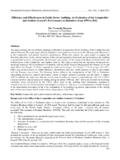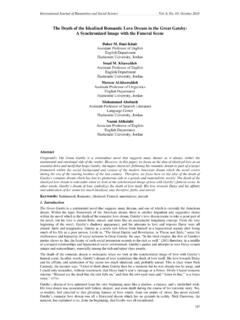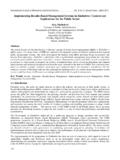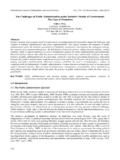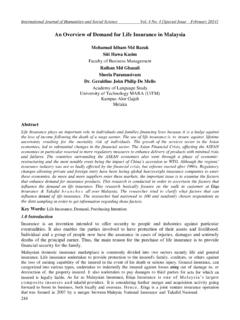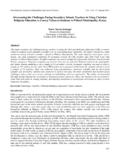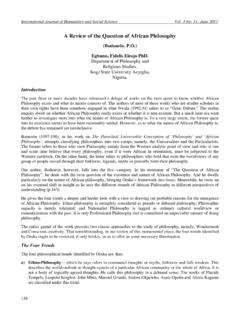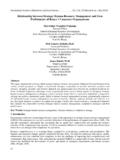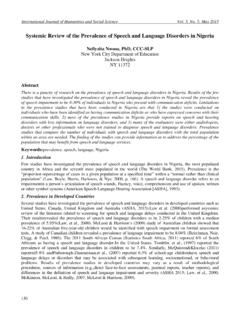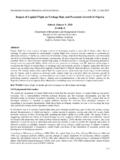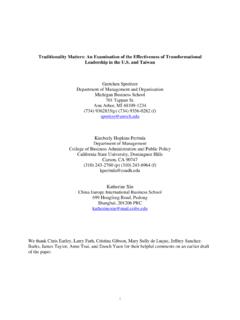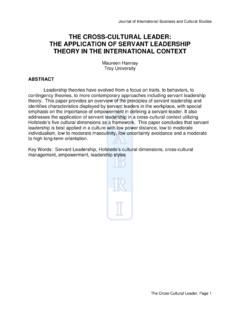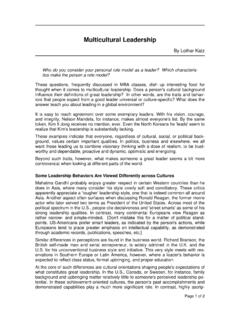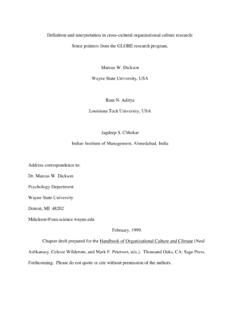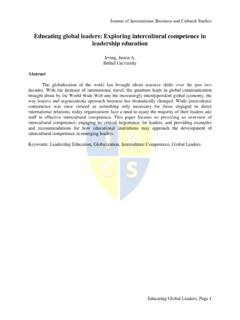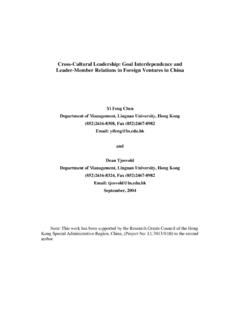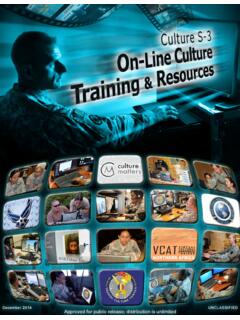Transcription of Critical Literature Analysis of Leadership and Cross ...
1 International Journal of Humanities and Social Science Vol. 6, No. 1; January 2016 137 Critical Literature Analysis of Leadership and Cross - cultural Management: A Glance on the UAE Higher Education Context Iman Rabah, EdD Management, Leadership , and Policy UAE, Dubai, Media City, building number 1 Office number 403, Box 4740 Abstract The purpose of this paper is to highlight appropriate Leadership and Cross - cultural models in higher education as a unique context. It focuses on scholar's recommendations for top administrators to lead faculty members in a proper way, especially since the higher education context is unique and Leadership within this context is unique as well.
2 The Literature of Cross - cultural management in higher education gives an important role to cultural awareness of leaders who need to understand the mind-sets and national characters of individuals such as their courtesies and customs. This paper also uses Hofstede's (1991) cultural dimensions in order to study the characteristics and cultural components of Emirati people and of expatriates who come from different countries like the , Britain, France, Spain, China etc. Keyword: Leadership , Cross - cultural Management, Higher Education, United Arab Emirates (UAE). Introduction This paper critically reviews the Literature of Leadership in the higher education context. Top administrators need to support faculty members and empower them in order to achieve a high quality of teaching and research.
3 Leaders should also know how to deal with politics in higher education since they have to keep it away from the university in many cases, and they should use it in other cases to bring resources to the university and create opportunities for faculty members (Ramsden, 1998). Creating a vision and working to achieve it is another essential role for higher education leaders in order to provide a high quality of teaching and research (Ramsden, 1998). This paper also reviews the Literature of Cross - cultural management, including Hofstede's (1984; 1986; 1991) discussions about the importance of leaders in achieving a successful Cross - cultural context and Trompenaars (1993), who differentiates between inner-directed people and outer-directed people and the impact on their careers and working environments.
4 In this paper there is also a review focusing on the Arab cultural characteristics specifically the UAE and expatriates cultural characteristics like the American, British, Spanish, French etc. cultures based on Hofstede's (1991) cultural dimensions model as the UAE includes expatriates from those countries. 1 Higher Educational Leadership Literature Higher educational Leadership has an important role among senior administrators to help academics preserve academic freedom. This section focuses on scholar's recommendations for top administrators to lead faculty members in a proper way, especially since the higher education context is unique and Leadership within this context is also unique.
5 The leader's skills vary by his level of education and knowledge, and leaders in higher education should have very high Leadership skills (Drucker, 1955). This section includes three main roles of higher education leaders that scholars focus on in the Literature of higher education Leadership . Firstly, it presents the way higher education leaders should lead faculty members. Ramsden (1998) argues that appropriate Leadership in higher education positively impacts faculty members in their role to achieve high qualities of teaching and research that are the two core activities of the university. According to Ramsden (1998), in this changing world that is affecting many western and Arab universities and shifting them into huge organizations, a higher education leaders' role is empowering faculty members and creating ownership on what they teach and the way they teach it, and this is essential and should be protected.
6 ISSN 2220-8488 (Print), 2221-0989 (Online) Center for Promoting Ideas, USA 138 Secondly, this section discusses how higher education leaders should deal with politics in universities and how they should have political intelligence in many cases in order to keep politics away from the university (Bezzina, Starratt and Burford, 2009). On the other side, higher education leaders should use politics to get best for the university by seeking resources and generating opportunities for faculty members (Ramsden, 1998). Thirdly, this section focuses on creating the right vision and working on achieving it regardless of all of the challenges those leaders may face.
7 The most important vision in higher education is building the academic community and creating an educational environment that goes even beyond the university and leaders should have clear objectives to achieve this vision (Murphy, 2002). Leading Faculty Members Evans and Lindsay (2005, p. 204) define Leadership as "the ability to positively influence people and systems under one's authority to have a meaningful impact and achieve results". Some higher education institutes are more focused on strategy, policy, and processes than Leadership (Osseo-Asare, Longbottom and Murphy, 2005, p. 158). Osseo-Asare, Longbottom and Murphy (2005) argue that Leadership is essential for vice-chancellors or presidents, deans, and heads of programs and departments in both academic and administrative departments.
8 Osseo-Asare and Longbottom and Murphy (2005) recommend that quality managers should be aware of this and support those administrators in developing and improving Leadership skills such as creating a mission and values, balancing research and teaching, and developing communication, empowerment, and support to academic staff. According to Osseo-Asare, Longbottom and Murphy (2005), Leadership should not be separated from processes since it is a skill that is integrated in everyday activity at all management levels. According to Seymour (2005), the main concern of higher education leaders is to ensure the future of the institute. Professors should be semi-autonomous and self-directed leaders in higher education (Carvalho and Downing, 2011; C t and Allahar, 2011;Deem, Hillyard, and Reed, 2007; De Wit, 2010; Fanghanel, 2009).
9 Leadership is crucial for the success of universities in this changing world according to many scholars. For example, Ramsden (1998, pp. 13-14) argues that the university has changed into a 'mass higher education system' in which leaders have to deal with, " [n]umbers, finances, structure, purposes, students, governance, confines, technologies, the amount of knowledge available and its diversity have all and will continue to have revolutionary consequences for how universities are run, what university staff do and how academic leaders work". According to Ramsden(1998), when 'executive leaders' like vice chancellors in higher education support faculty and communicate clear ideas of development and change to them, they help them in better teaching and more effective research processes.
10 Some scholars argue that academic leaders are different from other leaders since they are in a position of teaching and research, which constantly enhances their education and would give them the chance to distinguish themselves from different managers. According to Drucker (1955, pp. 415- 418), " Whether [the manager] develops his subordinates in the right direction, helps them to grow and become bigger and richer persons, will directly determine whether he himself will develop, will grow or wither, become richer or become impoverished, improve or [what] distinguishes the manager above all others is his educational one". Bottery (2004) defines five components of professional Leadership and management in education: provisionality ethics where leaders should be aware of the limits of their judgments, truth searching ethics where relativism is not accepted, integrity ethics where leaders should limit personal perceptions, humility ethics and considering personal fallibility as a factor of human being and not fail, and humanistic education ethics where the duty of leaders is helping people around them to help themselves.
